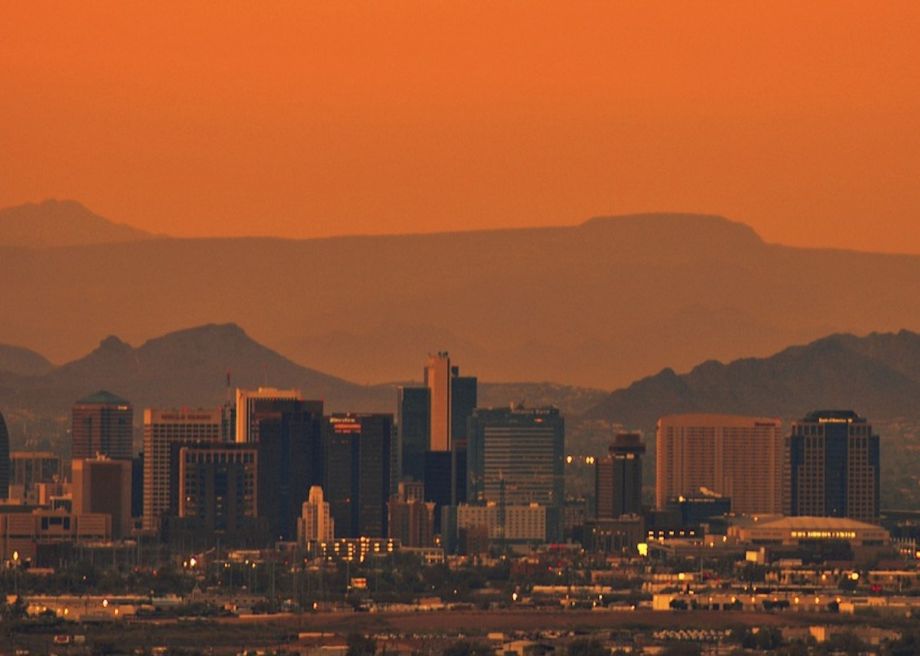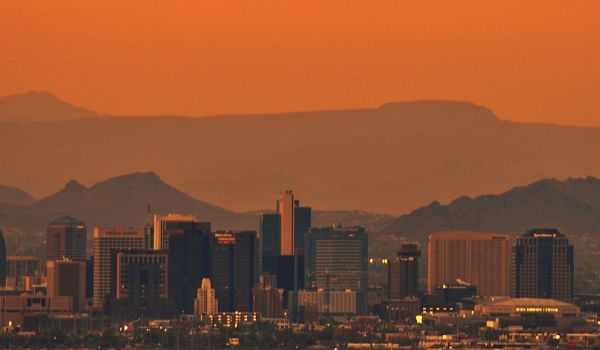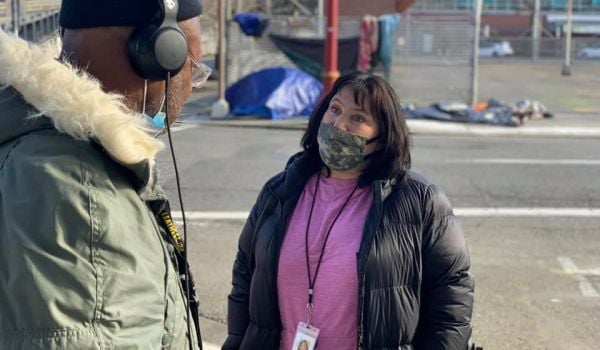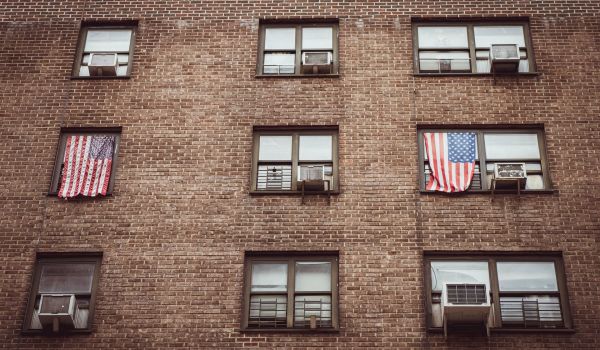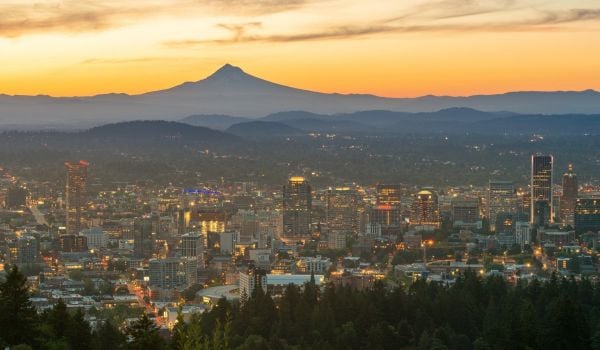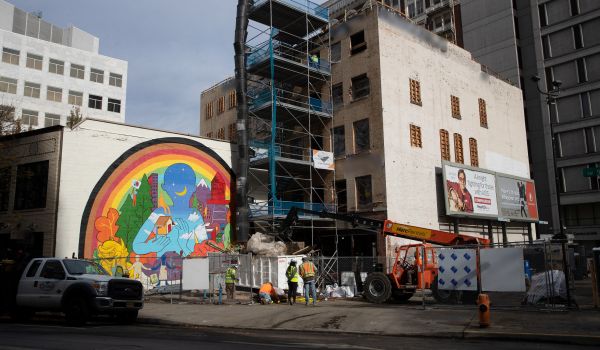Extreme heat killed dozens across the United States this summer. At least 96 people died in Oregon and 112 in Washington in late June as temperatures in the Pacific Northwest shattered previous record highs.
As weather forecasts warned of the incoming heat waves, cities across the region activated their emergency responses. In Portland, Oregon, the Multnomah County Department of Health spearheaded the response with other groups like the Portland Bureau of Emergency Management. “Portland and Multnomah County’s response to the June heat wave was probably the most significant heat response that we’ve ever had as a community,” says Dan Douthit, Public Information Officer at the Portland Bureau of Emergency Management. “But it wasn’t enough.”
Now, administrators are doing the difficult work of rooting out shortcomings and planning for the future. For Portland, this means shoring up their emergency response plans and thinking about how the city can be more heat-resilient. They’re grappling with the fact that they can no longer treat extreme heat like a once-in-a-while crisis. It’s becoming an every-summer reality.
This is a paradigm that those in desert cities like Phoenix, Arizona, are familiar with. They think about mitigating the effects of urban heat all the time, not only when it becomes an acute crisis. A recent heat action planning process led by city planners, climate experts, and community-based organizations in the Greater Phoenix area might provide a blueprint for cities like Portland as they update their approaches.
The more common emergency action plans for extreme heat events might mimic a city’s strategies for addressing something like a wildfire or an earthquake. These plans call for acute crisis responses, meaning things like sending emergency alerts and establishing emergency shelters. Cities with emergency action plans for dealing with heat activate them when an extreme heat warning is issued.
“With emergency plans, the objective is to provide thermal comfort for people immediately,” explains Melissa Guardaro, a professor at Arizona State University’s School of Sustainability and part of the core team behind the Phoenix Heat Action Plan. But she says that when cities only address extreme heat during a heat warning, they miss opportunities to implement more effective, equitable, and sustainable mitigation strategies. Planning for extreme heat should also mean addressing “social equity, environmental justice, the urban heat island effect, and how we are going to mitigate against a warming future,” says Guardaro.
The urban heat island effect occurs when pavement and buildings absorb and retain heat, making cities hotter. The effect is harshest in formerly redlined neighborhoods and others with less infrastructure investment and fewer green spaces. These same communities also tend to lack resources like cooling centers and parks that help residents cope with extreme heat.
Increased exposure to extreme heat is also linked to housing issues. Folks experiencing homelessness are more vulnerable, so are those in low-income neighborhoods where housing is less energy efficient and more likely to lack cooling systems. Mobile home residents are also particularly vulnerable, as many are on fixed incomes, do not qualify for utility assistance, and have limited shade to protect their homes. During the June heat wave in Oregon, heat-related deaths in mobile home parks were recorded in more than a dozen cities. Low-income folks are also disproportionately affected by the cost of extreme heat because they must spend a greater proportion of their incomes to cool their homes.
Phoenix’s heat action planning process took these things into account, and its ethos was simple: When cities take a more holistic approach to planning for heat, the effects of extreme heat will be less severe, and communities will be more prepared when it strikes. Solutions raised during the Phoenix planning process included installing shade along routes to local schools and transit nodes, creating signage for heat safety, and incentivizing infrastructure investment. Teams behind the project also connected community-based organizations with new grant opportunities and provided tools to help local leaders advocate for their communities in forums like city council or planning committee meetings.
Part of the process was also figuring out how nature fits into solutions, says Maggie Messerschmidt. Messerschmidt worked with The Nature Conservancy on the Phoenix plan and now works as a climate adaptation and resilience consultant at ICF. Multi-benefit solutions, which support communities and the environment, include “especially trees, but also things like green stormwater infrastructure, and how we capture water across landscapes to support a cooler city,” she says.
Sometimes, however, tragedy still strikes. But there are ways that cities can better respond then, as well. Phoenix’s Maricopa County now has a process in place to screen for heat as a cause or contributing factor of death. The New Republic reported last year that many scientists believe that heat deaths are substantially undercounted. “We have no idea of the magnitude of the problem unless medical reporting reflects heat as a contributing factor to underlying issues for those whose deaths are recorded as cardiovascular disease, diabetes, or asthma,” explains Guardaro. Without accurate and consistent screening, it’s more difficult to tailor solutions.
Douthit says that making Portland more resilient to heat has already come up in discussions surrounding the city’s 2021 Mitigation Action Plan. Portland’s Mitigation Action Plan is updated every five years and lays out how the city should respond to hazardous events like earthquakes, floods, winter storms, and now extreme heat.
“With the update that’s underway right now, based on the heat wave in June, there’s going to be some emphasis on looking at some things on the heat side that we can do over the next five years,” Douthit says. A couple of solutions his team is working on include strengthening relationships with community-based organizations and decentralizing cooling center locations.
The need for a diffuse network of cooling centers also came up in Phoenix, where certain centers operate continuously from May through September and additional locations are opened during heat warnings. There are also some local businesses that de facto serve as cooling centers year-round, like movie theatres or the central areas in shopping malls. Maintaining connections with those businesses and ensuring locals know where to access shelter before a heat wave hits is vital. “If you’re only open during a heat warning, you don’t have that infrastructure in place,” says Guardaro. Douthit says Portland’s plan to decentralize cooling centers also comes after receiving feedback that traveling across town to get to a cooling center was a barrier for some, even when free transportation was provided.
The success of sustainable, diffuse, community-oriented preparedness was already on display in Portland this summer in the work of the Joint Office of Homeless Services, a partnership between Multnomah County and the City of Portland that oversees the delivery of services to those experiencing homelessness. The Joint Office drew on its existing relationships with trained volunteers and community organizations and a fully-stocked supply center to deliver necessities like water bottles and cooling towels to unsheltered folks and provide transportation to cooling centers across Multnomah County during the recent heat waves.
“We’ve always done this kind of work,” says Denis Theriault, communications coordinator at the Joint Office of Homeless Services. “Being able to dramatically escalate that work during the heat event, it’s because we have the infrastructure and relationships.” Theriault estimates that his office distributed 80,000 bottles of water to people in need during the heat event in June. As things cooled off, two heat-related deaths were identified among those experiencing homelessness in Multnomah County. At last count in 2019, there were about 2,000 people experiencing homelessness in the county.
If cities in the Pacific Northwest learned anything from the recent heat waves, it’s that extreme heat events can no longer be treated as rarities. Cities not only need to shore up their crisis response plans but also explore more sustainable strategies for mitigating urban heat and protecting vulnerable communities. “Absolutely, both are necessary,” says Messerschmidt. “But the truth is, we’re dealing with a lot of climate impacts, and disproportionate impacts are felt because of other societal issues, so if we can find ways to implement solutions that are multi-benefit and focus on people’s needs, I think that’s where the magic happens.”
Editor’s Note: This article was updated with a new lead photo.


